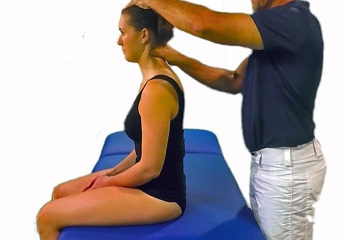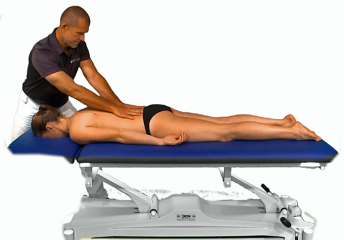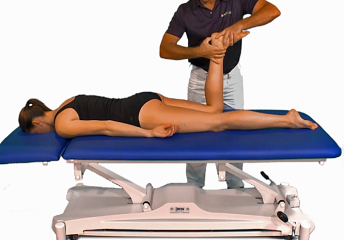M. erector spinae LS
M. ERECTOR SPINAE LS
Poloha pacienta: Leží na neošetřovaném boku. Ruka svrchní horní končetiny je položena na břichu v místě pupíku. Spodní horní končetina je položena paží na lehátku – flexe paže je kolem 60-80 stupňů a předloktí v pravém úhlu.
Postavení terapeuta: Stojí vedle lehátka, čelem k pacientovi.
Provedení: Terapeut nejprve musí upravit výchozí polohu pacienta. Spodní dolní končetina pacienta je v semiflexi, svrchní visí přes lehátko – pánev musí být mírně překlopena ventrálně. Pokud není dostatečná flexe bederní páteře, terapeut zatáhne za spodní paži pacienta k sobě, a tím flexi bederní páteře zvětší. Terapeut se poté postaví tak, aby svrchní dolní končetina pacienta byla mezi jeho stehny.
Dále terapeut provlékne svou ruku, která je blíže k hlavě pacienta, pod svrchní horní končetinou pacienta a položí prsty v místě TrP. Druhou ruku poté položí těsně k prstům první ruky tak, aby předloktí směřovalo šikmo přes bok. Terapeut se takhle postaví co nejblíže k pacientovi, ale na své ruce se dívat nemusí.
Izometrie: Tlak svrchní dolní končetiny pacienta proti vašemu stehnu. Pohled očí na opačnou stranu.
Facilitace: Nádech
Inhibice: Výdech, pohled očí dolů.
Chyby: Tato technika je relativně obtížná a chyb je možné udělat mnoho. Nejdůležitější je správné výchozí postavení pánve a bederní páteře.
M. ERECTOR SPINAE LS
Patient position: She is lying on her untreated side. The hand of the upper upper limb is placed on the abdomen at the navel. The lower upper extremity is placed with the arm on the couch – the flexion of the arm is around 60-80 degrees and the forearm at a right angle.
Position of the therapist: He stands next to the couch, facing the patient.
Execution: The therapist must first adjust the initial position of the patient. The lower limb of the patient is in semiflexion, the upper limb hangs over the couch – the pelvis must be slightly tilted ventrally. If there is insufficient flexion of the lumbar spine, the therapist pulls the lower arm of the patient towards him, thereby increasing the flexion of the lumbar spine. The therapist then positions himself so that the patient's upper and lower limbs are between his thighs.
Next, the therapist passes his hand, which is closer to the patient's head, under the patient's upper limb and places his fingers at the TrP site. The second hand is then placed close to the fingers of the first hand so that the forearm is directed diagonally across the hip. In this way, the therapist stands as close as possible to the patient, but does not have to look at his hands.
Isometrics: Pressure of the patient's upper leg against your thigh. View of the eyes on the opposite side.
Facilitation: A breath
Inhibition: Exhale, look down.
Errors: This technique is relatively difficult and many mistakes can be made. The most important thing is the correct initial position of the pelvis and lumbar spine.
SOUVISEJÍCÍ

M. erector spinae C

M. erector spinae Th a ThL

M. erector spinae LS

M. quadratus lumborum

M. rectus abdominis



















